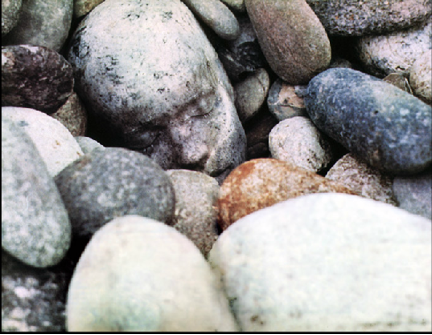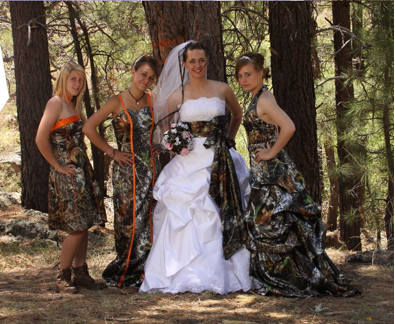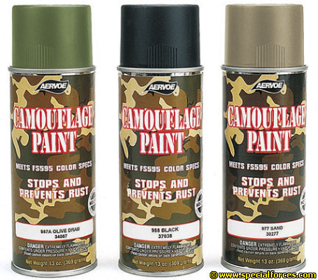
Veruschka in an early camouflage print, Stone Head, from Veruschka.net
Camouflage was designed to hide things, but how it changed our worldview may be its most revealing surprise. This five-part series examines the history of camo, from its humble origins to its current ubiquity. Catch up with Part I, Part II, Part III, Part IV.
PART FIVE: Beyond the Battlefield
Artists saw other ideas embedded within camo: the obliteration of self in society, mute protest against totalitarianism, the alienating distance of mass media.
Part of a series, Andy Warhol’s Camouflage Self-Portrait in 1986 shows his face in a Polaroid, silk-screened over with garishly colored U.S. Woodland. Here is camo as the distorting thicket of celebrity. Other artists who used recognizable military patterns include Pop artist Alain Jacquet, Adelle Lutz (in works like His/Hers Combat Lawn Furniture and camo-costumes for David Byrne’s 1986 film True Stories), Marilyn Lysohir, and David Bower.
Other artists skipped recognizable patterns and simply merged themselves into landscapes. Fashion model Vera Lehndorff (aka “Veruschka”) painted herself in the 1970s into African veldts, industrial wastelands and merry-go-rounds, an inversion of fashion’s usually celebratory, egocentric images. Chinese dissident Liu Bolin’s works comment on individuals steamrolled by modern China. In one work, he appears as a visual shimmer in front of a graffitti’d wall, which reads: IF YOU ARE NOT SEATED AT THE TABLE YOU ARE ON THE MENU. Dutch artist Desiree Palmen’s use of camouflage disturbs the air around a harmless-looking urban scene, as if souls took up physical space there.
Camo as Fashion
Camo now penetrates all levels of fashion. Musicians wear camouflage to support revolution of various kinds: from black power (Public Enemy) to Sinn Fein and African rights (U2 and Bono). Disruptively patterned graffiti helped camo infiltrate streetwear in the 1980 and 90s, like the camo-obsessed Maharishi line.
American designer Stephen Sprouse reproduced Warhol’s pop-camo in his 1987 collection, a tradition continued by Jean Paul Gaultier, Prabal Gurang and Patrik Ervell. Camo thus crossed over into the female, suggesting wit, beauty and toughness.
Hunters usually don’t share politics with designers, feminists, or rappers—but they do share a love of camo. Jim Crumley invented his own hunter-camo in the 1970s. His Trebark pattern spawned many imitators, including the popular Mossy Oak pattern. (When Noriega was finally captured wearing Trebark, Crumley considered using the Panamanian general in an ad campaign with the slogan: “No wonder it took so long to capture him.”) Hunters now wear their own camo-patterns, distancing them visually from the military.
Camouflage formalwear brings high and low fashion into collision; sites like CamoFormal.com and ATouchofCamo.com sell it briskly. Girls wearing camouflage formalwear signal a range of conflicting messages: I like to shoot; I’m proud of my hunting heritage; I can’t be pigeonholed; screw all this formality; look at me, in my gown designed to hide.
Civilian camo-wearers usually emphasize nonviolence. What else they’re subverting, however, can be harder to trace.

A variety of styles from ATouchofCamo.com
The Future of Camouflage
In the era of advanced radar and infrared, traditional camo is decidedly low-tech. But modern military tests prove and re-prove its effectiveness.
Nothing proves camo’s active status as a verb like its innovation pipeline. Various future of camo articles describe “stealth ponchos” concealing body heat, vinyl-adhesive photos to hide landmarks, fabrics embedded with fiber-optics that dynamically match their surroundings. Camo designer Guy Cramer claims to be perfecting technology that bends the light spectrum to make objects entirely disappear.
Camouflage’s final trick may be how thoroughly—indeed, invisibly—it pervades our modern world. Oscar Wilde once observed, “It is only shallow people who do not judge by appearances. The true mystery of the world is the visible, not the invisible.” Camouflage’s plain face masks a very modern awareness: that the visible world is constructed, contingent, shaped in ways we can barely guess at. Or, as this World War I-era poem by Ella Wheeler Wilcox puts it:
Camouflage is all the rage.
Ladies in their fight with age—
Soldiers in their fight with foes—
Demagogues who mask and pose
In the guise of statesmen—girls
Black of eyes with golden curls—
Politicians, votes in mind,
Smiling, affable and kind,
All use camouflage to-day.
As you go upon your way,
Walk with caution, move with care;
Camouflage is everywhere!

Camouflage spray paint on sale at SpecialForces.com.
Jude Stewart writes about design and culture for Slate, the Believer, Fast Company, and Print, among other publications. Her first book ROY G. BIV: An Exceedingly Surprising Book About Coloris now available from Bloomsbury. Follow her on Twitter @joodstew.




